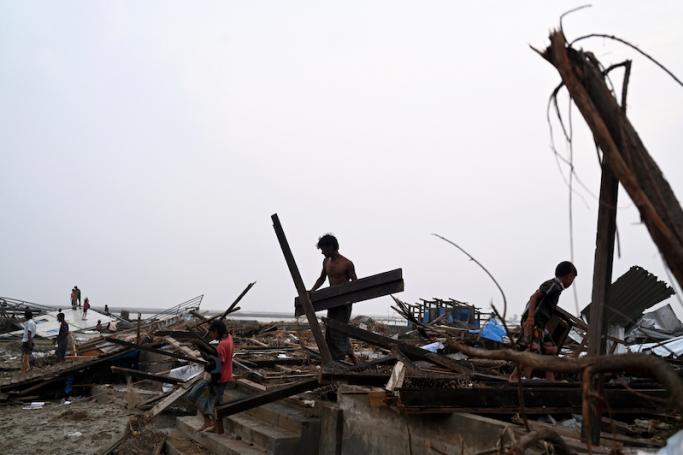Mizzima Editorial
As the Myanmar authorities and local and international humanitarian groups reach out to the vulnerable in a large swathe of northwestern Myanmar in the aftermath of Cyclone Mocha, it is gradually becoming clear that some of the painful lessons of the 2008 Cyclone Nargis have been learnt.
Consider the stark statistics. Cyclone Nargis killed over 130,000 people. Cyclone Mocha killed several hundred, although the full death tally has yet to come in.
Both cyclones were said to be Category 4 storms, packing similar strength winds, though Nargis appears to have covered a larger swathe of the country and at least anecdotally was more severe in its physical destruction.
All this raises the question as to whether the Myanmar authorities, NGOs and humanitarian groups took the right steps this time round? After all, Cyclone Nargis – and its mismanagement - was a horrifying wake-up call 15 years ago.
The answer to the question is both yes and no, at least in the immediate aftermath as people begin to clean up.
The obvious positive this time round was the action taken to evacuate people and baton down, with most people aware that the storm was coming due to the actions of the authorities and NGO groups - and the widespread ownership of mobile phones and social media that helped inform the citizenry, except though in areas such as Sagaing and Chin where the junta has blocked access to the internet for two years now.
Tens of thousands of people in vulnerable areas were evacuated or took it upon themselves to move voluntarily to safety, indicating that people thought it was better to be safe than sorry as Cyclone Mocha barreled towards them.
Sensible move.
At this point in time, the total death toll from Cyclone Mocha is not in. From a death toll of five, to 39, to 81, to hundreds, the toll appears substantially different compared with the carnage that was Cyclone Nargis. While we will have to wait a few more days to get the final death tally, a few hundred dead from Mocha can be considered to be far better than 130,000 toll from Nargis.
Now the big challenge is to provide enough food, medicine and shelter for those negatively affected. Even the United Nations has expressed concern that their humanitarian coffers are only partially funded. And NGOs are concerned that internally displaced people (IDPs) – particularly in active war zones – will be at particular risk.
Key elements are at play that indicate the Myanmar junta has been using Cyclone Mocha and its aftermath as a tool in their war against their people. This is clear from their actions – or their failure to act. For example, in Sagaing region, just as the rains and winds were coming in on 14 May, junta soldiers were shelling villages, as they continued their battle against the Spring Revolution resistance. And the junta failed to evacuate Rohingya IDPs from low-lying camps in Rakhine, resulting in a death toll possibly in the hundreds – mostly women and children – who were swept away in the floods.
Of course, the majority of the people including in large parts of Rakhine State – the worst hit - did not expect the military regime to help them based on their past experience and took care of themselves with whatever came from the regime but also from their own local authorities, such as Arakan Army in Rakhine State and the National Unity Government (NUG) and PDFs in conflict areas such as Sagaing and Chin.
What is clear is that the State Administration Council (SAC) and its ministries did little or nothing to set up temporary shelters and there are questions over the humanitarian funding they publicized. The SAC said it raised more than MMK 100,000 lakhs and donated MMK 70,000 lakhs to their own Rakhine government but do we know who contributed this money and there are questions over transparency and who will benefit. Given the tradition of discrimination and militarization, it can be expected that the money will be used for their own political and military purposes in Rakhine and elsewhere.
Then there is the question of aid from INGOs and NGOs based in Myanmar. Will they step out of their comfort zone to go against the wishes of the SAC and provide aid to such areas in need as Sagaing and the Chin and Kachin states? Will this mean support only for Rakhine and to the areas the SAC prescribe?
Given these concerns, have lessons really been learnt from Cyclone Nargis? Yes, for the majority. But for a vast swathe of people living in areas of resistance, or the Rohingya living in camps, yet again a natural disaster is being politicized by the Naypyidaw hierarchy in their ivory tower to decide who lives and who dies and who they deign worthy to receive humanitarian handouts.
As the clean-up and humanitarian aid delivery moves ahead, chances are the junta will block or hinder help being given to those in the heart of the conflict zones, and to certain IDP camps where the inhabitants do not fit the junta’s guidelines for citizenship.
Watch carefully in the coming days and weeks as this hateful division plays out.












